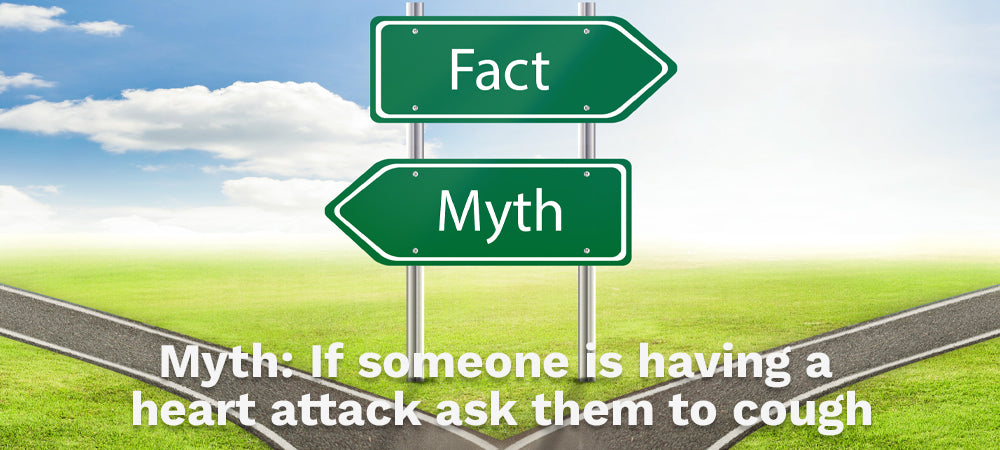Top First Aid Myths & Facts

First Aid may seem like a simple concept, but it's easy to get into the mindset that you know all there is about first aid. You might have seen movies or TV shows like ER, Grey's Anatomy or New Amsterdam, where people are giving out tutorials on how to be provide first aid. But what would happen if these techniques were ever needed for real life situations.
In our modern world with its medical advancements and technology at hand many individuals think they're qualified when actually having very little knowledge outside their own home.
The reality is there is still a lot of misconceptions about what to do when someone gets sick or injured. The old ways may no longer be safe, some methods have been proven as false or replaced by better methods due to advanced in modern science. Some of the old first aid myths, that no matter how many times we explain them, still insist on remaining in the minds of those "trying to help". Here are our top first aid myths and the facts, in no particular order:
Let’s get started
Our guide to the requirement for first aid in the workplace includes:
 Myth: Use butter to help a burn
Myth: Use butter to help a burn
The MYTH is that if someone burns themselves on a hot stove, iron or an a pan for example, the first thing you should cover it with butter to stop the burning. Should you do this? No, you should avoid putting any grease on the burn. The idea was that it forms a barrier to protect the area, the problem is that it actually traps heat in the skin having the opposite effect and in turn make the burn worse.
The FACTS are that the simplest and most effective solution for a burn to reduce the pain and heat is to rinse it with cool or cold clean water. The cool water temperature will cleaning, cleanse and and soothe your skin. Try and do this for between 15 - 30 minutes. For a full background on the why butter became folk law, check out this BBC article.
 Myth: You can get sued for giving first aid
Myth: You can get sued for giving first aid
The MYTH is that you can be sued by a victim or the family of a victim if something goes wrong after giving CPR or first aid.
The FACTS are when it comes to BLS (basic life support) being given to a casualty who is not breathing and not responding, then without care death is inevitable. As such there is no way that the person could be made worse than death. As such in the event of providing CPR/BLS the victim could only have been helped by the care that was given. AED also comes into the same bracket as BLS as the AED will only deliver a shock to someone who needs it. The only caveat that could lead a first aider to being legally liable is if the victim/patient was left in a worse position than if no first aid was given.
 Myth: Make someone throw up poison
Myth: Make someone throw up poison
The MYTH is that it is better to force someone to vomit if they have swallowed a poison such as bleach.
The FACTS are that if the substance may not have damanged the esophagus on the way down. When someone forcefully vomits it can cause tears in the lining of the esophagus, the tube that connects your throat to your stomach. If they are forced to vomit affected the airway can be damaged on the way back up with the combination of the poison mixed together with stomach acid. The combination could cause internal bleeding ort bleeding on the way back up. The most important thing to do is call the emergency services and tell them what the person has consume, they will be able to guide you with the most appropriate course of action to take.
 Myth: If someone is having a heart attack ask them to cough
Myth: If someone is having a heart attack ask them to cough
The MYTH is that according to multiple sources including the British Heart Foundation and the American Heart Association (yes the BHF and AHA both agree on this) if you are having a heart attack to cough to continue to force blood through the heart and suply the brain with enough blood to remain concious until help arrives.
The FACTS are that according theif the substance may not have damanged the esophagus on the way down. When someone forcefully vomits it can cause tears in the lining of the esophagus, the tube that connects your throat to your stomach. If they are forced to vomit affected the airway can be damaged on the way back up with the combination of the poison mixed together with stomach acid. The combination could cause internal bleeding ort bleeding on the way back up. The most important thing to do is call the emergency services and tell them what the person has consume, they will be able to guide you with the most appropriate course of action to take.
 Myth: Tilt your head back to stop a nosebleed
Myth: Tilt your head back to stop a nosebleed
The MYTH is that to stop a nose bleed tilt your head back.
The FACTS are that it is important to lean the casualty forward and let the blood drain from nose rather than tilting head back where it could run down throat. Tilting back can cause vomiting or suffocating. It also good practice pinch nostrils while asking person breathe through mouth.
